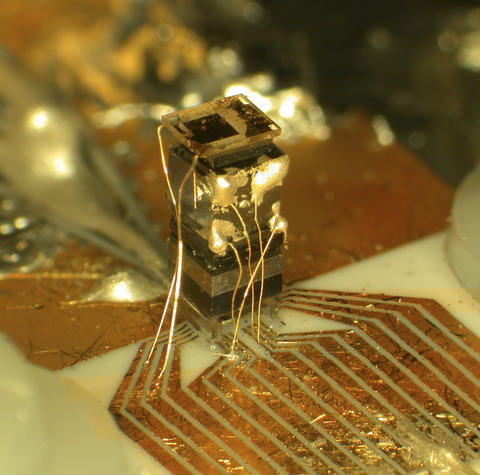
The physics package of the NIST chip-scale atomic clock includes (from the bottom) a laser, a lens, an optical attenuator to reduce the laser power, a waveplate that changes the polarization of the light, a cell containing a vapor of cesium atoms, and (on top) a photodiode to detect the laser light transmitted through the cell. The tiny gold wires provide electrical connections to the electronics for the clock.
A new website has been launched by the National Institute of Standards and Technology (NIST) to serve as a central resource for technology transfer plans developed by agencies with federal research laboratories.
The plans were developed in response to an Oct. 28, 2011, Presidential Memorandum that directed agencies doing research and development to foster innovation by increasing the rate of technology transfer to private-sector organizations so that research results could be adapted for use in the marketplace.
The plans from 13 federal agencies include agency-defined goals and metrics to measure progress and evaluate the success of new efforts that encourage technology transfer activities. This effort supports the policy of using innovation as a tool to increase economic growth, create jobs, and enhance global competitiveness of U.S. industries.
As part of its own effort to accelerate technology transfer, NIST plans to revise its definition of technology transfer to more accurately report and evaluate a broad range of technical activities. This will lead to expanded metrics tracking the use of Standard Reference Materials and Data, patents and licenses, and collaborations. New metrics will cover software downloads, postdoctoral and guest researchers, and start-up companies, among others.
NIST develops basic science foundations for many technologies with long horizons for eventual commercialization, while other NIST activities benefit the economy through facilitation of consensus standards for trade. As one mechanism for tracking technology transfer activities, the agency plans to expand a database on staff participation in private-sector consensus standards committees. The expanded Standards Committee Participation Database will go beyond statutory requirements for data collection regarding staff participation in committees and on standards developed through their efforts.
In addition to NIST, the DOC technology transfer report includes plans from the:
- National Oceanic and Atmospheric Administration (NOAA), which disseminates applications resulting from its meteorological and oceanographic technologies to individuals, industry, government and universities to support its mission goals of climate adaptation and mitigation, a weather-ready nation, healthy oceans and resilient coastal communities and economies.
- Institute of Telecommunication Sciences (ITS), the chief research and engineering arm of the National Telecommunications and Information Administration (NTIA). ITS uses three principal means for achieving technology transfer: cooperative research and development, technical publications, and leadership and technical contributions in the development of telecommunications standards.
The agency reports for "Accelerating Technology Transfer and Commercialization of Federal Research in Support of High-Growth Businesses" are available at www.nist.gov/tpo/publications/agency-responses-presidential-memo.cfm.

